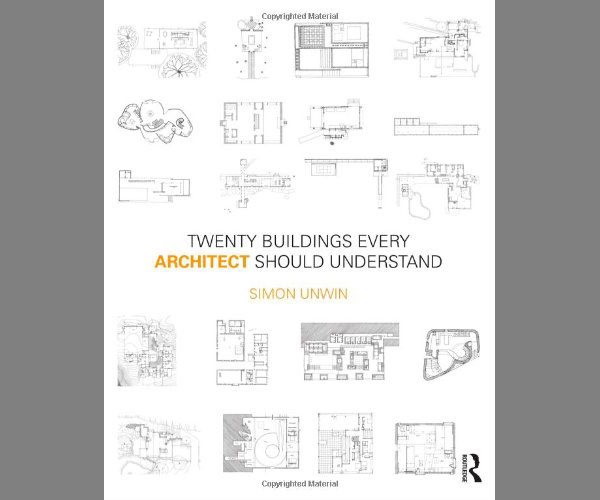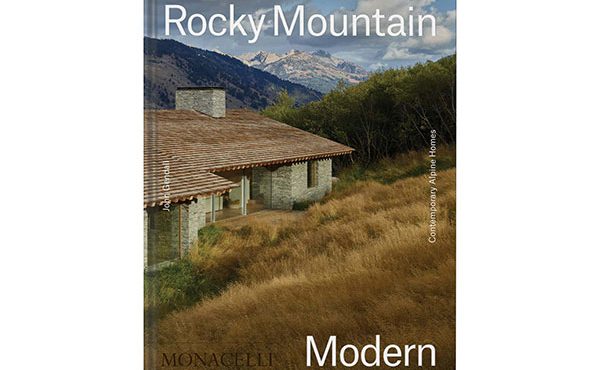
Author: Simon Unwin (Routledge, 2010)
At a time when meaningful analyses of the built environment seems to be suffering from extreme attrition, Simon Unwin’s Twenty Buildings Every Architect Should Understand is an informative and insightful testing of the powerful conceptual framework he put forth in his well-known Analysing Architecture. It is the second in a trilogy targeted at introducing readers to how to look at and learn the nature – and potential – of architecture. The trio focuses on three aspects of learning – theory (Analysing Architecture), examples (Twenty Buildings Every Architect Should Understand) and practice (Exercises in Architecture: Learning to Think as an Architect).
As in his first book, Twenty Buildings… is straightforwardly structured. Each of the twenty buildings included occupies its own chapter and are bookended by a thoughtful Introduction and Endword. These are divided into subsections that generally make reference to the analytical framework of Analysing Architecture. As is Unwin’s trademark, the book is filled solely with his incredible analytical drawings that speak directly to the content described.
According to Unwin, the buildings included were chosen for their diversity of spaces and “their differing suggestions about the relationship between architecture and the people”. As one can see from the following list of buildings in the book, they do justice well to the authors words and offer readers an good variety of interesting selections:
- Casa Del Ojo De Agua, Ada Dewes and Sergio Puente
- Neuendorf House, John Pawson and Claudio Silvestrin
- Barcelona Pavilion, Mies Van Der Rohe
- Truss Wall House, Kathryn Findlay and Eisaku Ushida
- Endless House, Frederick Kiesler
- Farnsworth House, Mies Van Der Rohe
- La Congiunta, Peter Markli
- Un Cabanon, Le Corbusier
- Esherick House, Louis Kahn
- Maison À Bordeaux, Rem Koolhaas
- Danteum, Giuseppe Terragni
- Fallingwater, Frank Lloyd Wright
- Villa Savoye, Le Corbusier
- Kempsey Guest Studio, Glenn Murcutt
- Condominium One – The Sea Ranch, Moore, Lyndon, Turnbull. Whitaker
- Villa E.1027, Eileen Gray
- Church of St Peter, Sigurd Lewerentz
- Villa Busk, Sverre Fehn
- Villa Mairea, Alvar Aalto
- Vals Thermal Baths, Peter Zumthor
Overall, Twenty Buildings… offers readers an excellent series of case study analyses that testify to the power of the analysis tools Unwin laid out in Analysing Architecture. That being said, through this book, he also demonstrates that conceptual framework described in his earlier book does best when not used mindlessly as a checklist, but instead as a method of ‘getting into’ architectural analyses. The themes of Analysing Architecture are within the description of each building, but they are not solely described in those terms. This fact strengthens the book by allowing readers who have not read his original book to gain just as much out of Twenty Buildings… as those who have. Of course, given the strength of Unwin’s initial book, one would be wise to read it, regardless.
If there is a way to make Twenty Buildings… even stronger it would be to include a handful of vernacular architecture examples. With the number of analyses Unwin has already done in other texts – for example, that of the Mud House and Llainfadyn buildings at the end of Analysing Architecture or his Skara Brae eBook – one guesses that this would be an easy addition to the good range of well- and lesser-known architect-design buildings already included. Perhaps in a future edition.
Admittedly, this is nitpicking. Twenty Buildings Every Architect Should Understand is simply an excellent book. Truly a perfect text for students of architecture and professionals alike….or simply those interested in getting a taste of amazingly diverse language of architecture.
***
For more information, visit the Routledge website – . Visit Simon Unwin’s website to see all his books including his wonderful eBooks series. You can also read the Spacing Vancouver review of Analysing Architecture here.
**
Erick Villagomez is one of the founding editors at Spacing Vancouver. He is also an educator, independent researcher and designer with personal and professional interests in the urban landscapes. His private practice – Metis Design|Build – is an innovative practice dedicated to a collaborative and ecologically responsible approach to the design and construction of places. You can see more of his artwork on his Visual Thoughts Tumblr.



